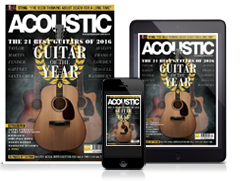Marshall AS100D
An acoustic amplifier packed with 100 watts, four channels, digital effects and a twin speaker cabinet?
Acoustic guitars are, as we know, polite creatures. They talk in civilised tones, don't upset the neighbours, and won't wake your sleeping baby. Sometimes, however, you might want your acoustic to shout like a drunken reveller, and for those times, there's the AS100D.
Build quality and features
The bigger brother of the Marshall range is big; really big. Perhaps not as big as Douglas Adams would have you understand space to be, but big enough that you might expect it to be carrying more than 100 watts. It has a typical Marshall look, but in the brown leatherette that distinguishes the acoustic range from the always-black electric amps. The slanted front panel is equipped with a vast array of controls, and that's because the amp is equipped with no fewer than four channels, and forms, essentially, a mini PA system. Channel one, intended as the primary guitar channel, has a stereo jack input, and a three-band EQ with a sweepable mid, so you can get your cut and boost just where you want it. As well as being suitable for a second guitar or a mic, channel two can be used to link to channel 1 in stereo mode.
With the Link Ch1 button pressed, the volume and two-band EQ control the signal from the ring of a stereo jack plugged into channel one. Channel three is an XLR only channel, intended for mics, and is the only channel with independent control over the levels of both internal and external effects, suggesting it is intended to be the primary channel for vocals. Channel four is an auxiliary channel; all you get is a stereo RCA input and a volume control, so it's ideal for plugging in an MP3 player or something similar.
There are also a range of controls which affect several, or all channels; a notch filter with, unusually, two separate controls, meaning you can minimise two troublesome frequencies in the event of feedback, and a digital FX section. The latter can be switched in and out with a front panel button, as can the external effects loop, but both can apparently be switched with the supplied footswitch.
Since this has only a single switch, it presumably switches both at once, but the owner's manual, the English section of which extends to a paltry 3 pages, does not specify. The effects are generous, with a range of hall, room and plate reverbs, with the modulation effects bringing the total to 16, plus parameter and mix controls (the latter labelled level) which equally effect all channels, unless Ch3 is switched away from them. The back panel is a little more restrained, with an effects loop, line and DI outs and the footswitch jack being the only residents.
The sheer size of the Marshall is dictated partly by the extraordinarily populous front panel, but also due to the presence of two eight-inch speakers, distinguishing it from the many combos which go for a larger, single woofer. Watts can be measured in so many ways that they aren't always a good comparison, but the 100 on tap here suggest that Marshall are not intending this to attempt to be a PA for anything other than small venues, and that may be a smart decision. There are some acoustic amps with much higher outputs, but perhaps those are more focussed on simply being guitar amps, arguably a less exacting task.
Sound quality
The good news is that the Marshall doesn't seem to have a bad sound in it. After the standard start of setting the EQ flat, it required a conscious effort to remember to tweak it around; the sound was just as you'd hope it to be from the first touch. Whilst theoretically an acoustic amp should strive for transparency, as soon as you put anything other than air between the vibrating wood and your ears, it has an impact, and whilst the sonic footprint of acoustic amps is significantly more subtle than their electric brethren, it's absolutely there. In the case of the Marshall, it's a big, warm sound, very full and spacious sounding, which is rather as you'd hope.
Get the MusicRadar Newsletter
Want all the hottest music and gear news, reviews, deals, features and more, direct to your inbox? Sign up here.
Tweaking around with the EQ reveals that a good range of tone is available, but if you have a nice tone from your guitar's pickup, you'll probably only need to do so to make yourself more audible in ensemble situations. The effects are great, though like most such units, they can be overwhelming if you dial in too much. Keep them within the bounds of merely whelming, however, and they whelm with alacrity. The reverbs in particular can, used judiciously, bring your tone to life if you're in a dry sounding room.
Whilst this is a great sounding amp, it's definitely intended for stage use. If you want a nice tone for your guitar alone, around the house and practise room, this big lump of an amp is going to stretch your arm far more than is really merited. If, however, you want a good stage amp which can cut it even when you need two guitars and vocals, it might just be the amp for you. At a keen price, too!


“Its mission is simple: unleash the power of any amplifier or line-level source without compromise”: Two Notes promises a “watershed” in tube amp control with the Torpedo Reload II
“A pedal that sings with harmonic richness and blooming touch response”: Tone King offers up boutique tube amp tones for your pedalboard with the Imperial Preamp









